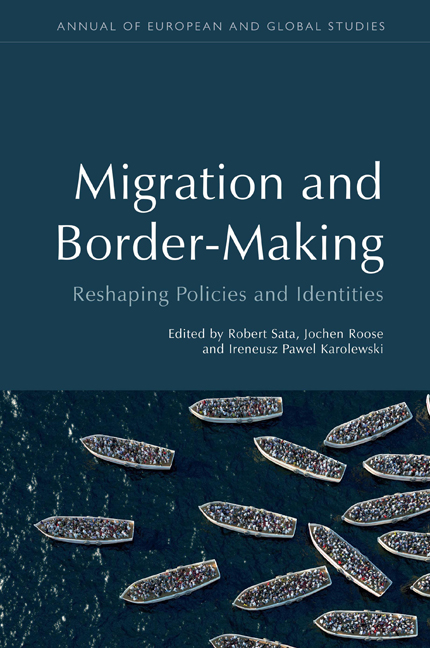Book contents
- Frontmatter
- Contents
- List of Contributors
- Introduction: Patterns and Implications of Migration and Rebordering
- 1 Do Migrants Think Differently about Migration? An Experimentum Crucis for Explaining Attitudes on Migration
- 2 Fencing in the Boundaries of the Community: Migration, Nationalism and Populism in Hungary
- 3 Rethinking Refugee Integration: The Importance of Core Values for Cultural Debate in Germany
- 4 The Unfolding of the Syrian Refugee Crisis in Turkey: From Temporariness to Permanency
- 5 The Middle Eastern Refugee Crisis and the So-Called Islamic State: Motivations of Iraqi Yazidis for Migrating to Europe
- 6 Current Migration Trends in Russia: The Role of the CIS Region Twenty Years after the Collapse of the Soviet Union
- 7 The North Amazon Border: Haitian Flow to Brazil and New Policies
- 8 Macedonian Refugees from the Greek Civil War: From Separation to a Transnational Community
- Index
8 - Macedonian Refugees from the Greek Civil War: From Separation to a Transnational Community
Published online by Cambridge University Press: 08 October 2020
- Frontmatter
- Contents
- List of Contributors
- Introduction: Patterns and Implications of Migration and Rebordering
- 1 Do Migrants Think Differently about Migration? An Experimentum Crucis for Explaining Attitudes on Migration
- 2 Fencing in the Boundaries of the Community: Migration, Nationalism and Populism in Hungary
- 3 Rethinking Refugee Integration: The Importance of Core Values for Cultural Debate in Germany
- 4 The Unfolding of the Syrian Refugee Crisis in Turkey: From Temporariness to Permanency
- 5 The Middle Eastern Refugee Crisis and the So-Called Islamic State: Motivations of Iraqi Yazidis for Migrating to Europe
- 6 Current Migration Trends in Russia: The Role of the CIS Region Twenty Years after the Collapse of the Soviet Union
- 7 The North Amazon Border: Haitian Flow to Brazil and New Policies
- 8 Macedonian Refugees from the Greek Civil War: From Separation to a Transnational Community
- Index
Summary
STARTING IN 1948, Poland accommodated a large number of refugees from the Greek Civil War – both ethnic Greeks and ethnic Macedonians. Even though the general pattern of migration as well as the institutional care provided by Poland was similar for both groups of migrants, I argue that Macedonian migration to Poland was a different phenomenon from the Greek one. There are two main characteristics. First of all the Macedonians in Poland were a ‘minority within the minority’ and this condition influenced their trajectories as a separate group. Second, the Macedonian migration to Poland is deeply rooted in the political situation of Europe after World War II, which had an impact on actual Macedonian possibilities (i.e. connected to repatriation or war compensation) as well as the politics of remembrance, which stay closely related to identity. The chapter develops the characteristics of Macedonians migration and focuses on the processes shaping the identity of migrants, including how facing old and new borders translates into new conceptions of both the self and others. The text follows chronological order, discussing issues of ‘separation’ via ‘assimilation’ to a ‘new space of identification’. The three problem fields connected with Macedonian identity are the question of the Macedonian homeland(s); integration within the refugees’ group and with Poles; and self-organisation, politics and the politics of remembrance. I base my analysis on biographical interviews with Macedonian refugees (who were mostly children at that time), which I conducted in Poland, Macedonia and Canada, as well as on selected documents from Polish and Macedonian archives.
It was the autumn of 1948 when the first train with refugees from the Greek Civil War crossed the Polish–Czechoslovakian border. The first refugees were children, a total of 1,048. The following years brought even more transports to Poland: 800 children arrived in April 1949, and another 200 in August 1949. Then the refugees started coming by the sea: both adults and youths. In July, September and October 1949, ships with refugees came to Polish ports in Świnoujście, Dziwnów and Gdańsk. In 1950, the total number of refugees in Poland was 10,722. By 1955, as a result of family reunification, the number increased to 15,215 (Słabig 2008: 314).
- Type
- Chapter
- Information
- Transnational Migration and Border-MakingReshaping Policies and Identities, pp. 189 - 208Publisher: Edinburgh University PressPrint publication year: 2020



